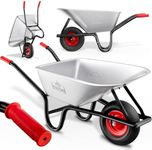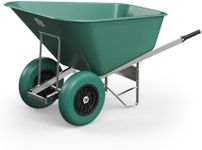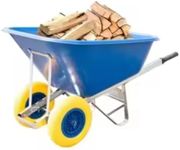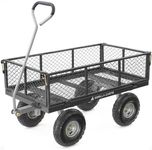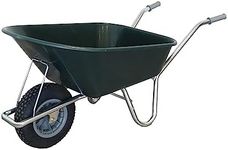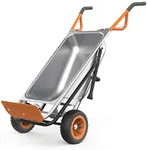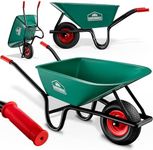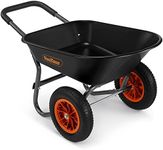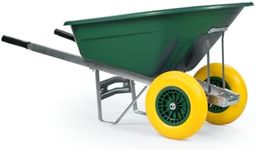Buying Guide for the Best Wheelbarrows
Choosing the right wheelbarrow can make your gardening, construction, or any other heavy-duty tasks much easier. The right wheelbarrow will help you transport materials efficiently and with less strain on your body. When selecting a wheelbarrow, consider the type of tasks you'll be performing, the terrain you'll be working on, and your own physical capabilities. Here are some key specifications to consider when choosing a wheelbarrow.CapacityCapacity refers to the volume and weight that a wheelbarrow can carry. This is important because it determines how much material you can move in one trip. Capacities are usually measured in cubic feet or liters for volume and pounds or kilograms for weight. For light gardening tasks, a smaller capacity (around 4-6 cubic feet) may be sufficient. For heavier tasks like construction, a larger capacity (6-10 cubic feet) is more appropriate. Choose a capacity that matches the typical load you expect to carry to avoid overloading and straining yourself.
Wheel TypeWheel type affects the maneuverability and stability of the wheelbarrow. There are generally two types: single-wheel and dual-wheel. Single-wheel wheelbarrows are more maneuverable and can navigate tight spaces easily, making them ideal for gardening. Dual-wheel wheelbarrows offer better stability and are less likely to tip over, which is useful for carrying heavy loads on uneven terrain. Consider the terrain and the type of loads you'll be carrying when choosing the wheel type.
MaterialWheelbarrows are typically made from steel, plastic, or a combination of both. Steel wheelbarrows are very durable and can handle heavy loads, making them suitable for construction and heavy-duty tasks. However, they are heavier and can rust if not properly maintained. Plastic wheelbarrows are lighter and resistant to rust, making them easier to handle and maintain, but they may not be as durable for heavy loads. Choose a material based on the type of tasks you'll be performing and your preference for weight and maintenance.
Handle TypeHandles can be made from wood, steel, or plastic, and their design affects comfort and control. Wooden handles are comfortable to grip and absorb shock well, but they can splinter over time. Steel handles are very durable but can be less comfortable without padding. Plastic handles are lightweight and resistant to weather, but may not be as strong. Additionally, some wheelbarrows have ergonomic handles designed to reduce strain on your hands and wrists. Consider the handle type that feels most comfortable and provides the best control for you.
Tire TypeTires can be pneumatic (air-filled) or solid. Pneumatic tires provide better shock absorption and a smoother ride, making them ideal for rough or uneven terrain. However, they can go flat and require maintenance. Solid tires are maintenance-free and cannot go flat, but they do not absorb shocks as well and can be harder to push on rough terrain. Choose the tire type based on the terrain you'll be working on and your preference for maintenance.
FrameThe frame of the wheelbarrow supports the load and affects its overall durability and stability. Frames are usually made from steel or aluminum. Steel frames are very strong and can handle heavy loads, but they are heavier and can rust. Aluminum frames are lighter and resistant to rust, but may not be as strong for very heavy loads. Consider the frame material based on the weight of the loads you'll be carrying and your preference for weight and maintenance.
